CHECK IF THE GIVEN ANGLE IN STANDARD POSITION
Subscribe to our ▶️ YouTube channel 🔴 for the latest videos, updates, and tips.
An angle is said to be an angle in standard position if its vertex is at the origin of a coordinate grid and its initial arm coincides with the positive x-axis.
The position of an angle when its initial arm is on the positive x-axis and its vertex is at the origin.

Example 1 :
Is the following angle, θ, in standard position ?
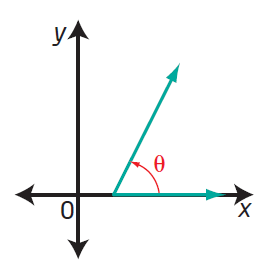
Solution :
In the picture given above the angle is not in the standard position.
Explanation :
The vertex of initial arm and terminal arm is not at origin.
Example 2 :
Is the following angle, θ, in standard position ?
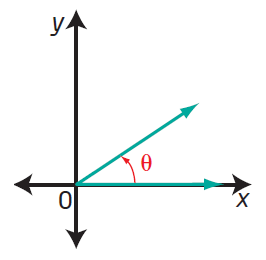
Solution :
In the picture given above the angle is in the standard position.
Explanation :
The vertex is at origin and initial arm is in x axis. Hence the given angle is in standard position.
Example 3 :
Is the following angle, θ, in standard position ?
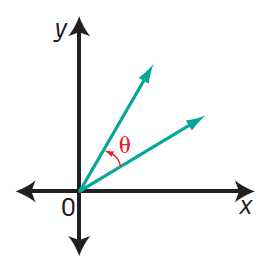
Solution :
In the picture given above the angle is not in the standard position.
Explanation :
The initial arm is not on the x-axis.
Example 4 :
Is the following angle, θ, in standard position ?
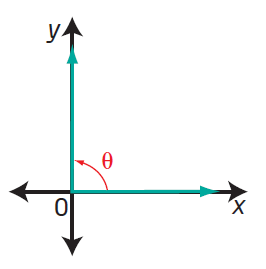
Solution :
In the picture given above the angle is in the standard position.
Explanation :
The vertex is at origin and initial arm is in x axis. Hence the given angle is in standard position.
Example 5 :
Without measuring, match each angle with a diagram of the angle in standard position.
(a) 150° (b) 180° (c) 45° (d) 320°
(e) 215° (f) 270°
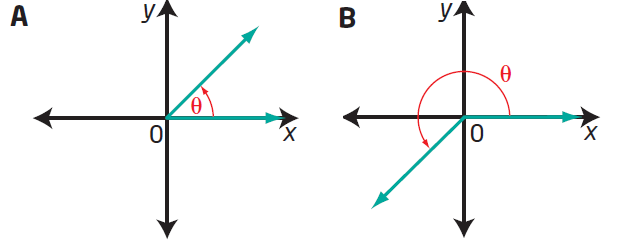
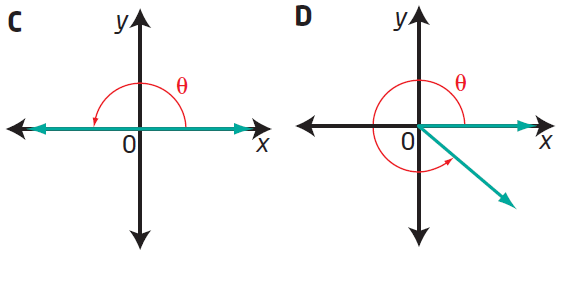
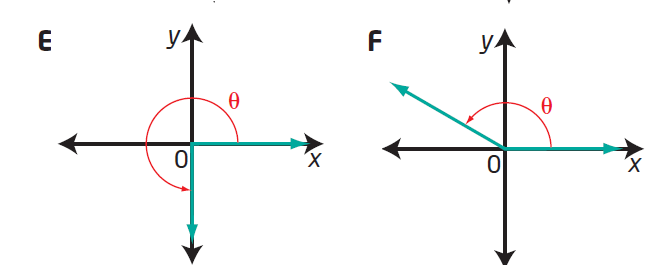
Solution :
(a) 150
It is greater than 90 but lesser than 180.The picture F represents angle 150.
(b) Picture C represents 180 degree.
(c) 45
45 degree is greater than 0 but lesser than 90. Picture A represents 45 degree.
(d) 320
320 degree is greater than 270 and lesser than 360. Picture D represents 320 degree.
(e) 215
215 is greater than 180 but lesser than 270, picture B represents 215.
(f) 270
Picture F represents 270 degree.
Example 6 :
Draw the angle with the given measure in standard position.
1) −340° 2) 150° 3) −185°
4) 300° 5) −340°
Solution :
1) −340°
Since it is negative angle measure, we have to go clockwise direction of rotation. The angle measure lies between -270 to -360, so the terminal arm should lie in the fourth quadrant.
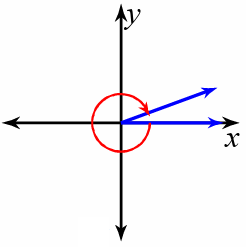
2) 150°
Since it is positive angle measure, we have to go for counter clockwise rotation. The given angle measure lies between 90 degree to 180 degree. Then the terminal arm will lie in the second quadrant.
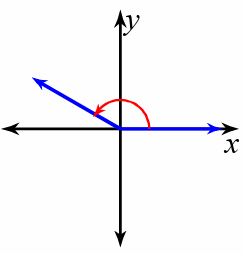
3) −185°
Since it is negative angle measure, we have to go for clockwise rotation. The given angle measure lies between 180 degree to 270 degree. Then the terminal arm will lie in the second quadrant.
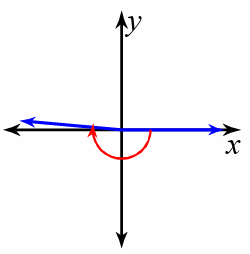
4) 300°
Since it is positive angle measure, we have to go for counter clockwise rotation. The given angle measure lies between 270 degree to 360 degree. Then the terminal arm will lie in the fourth quadrant.
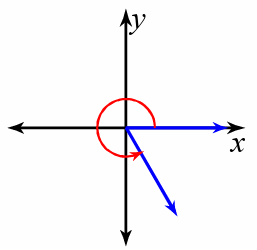
5) −340°
Since it is negative angle measure, we have to go for clockwise rotation. The given angle measure lies between -270 degree to -360 degree. Then the terminal arm will lie in the first quadrant.
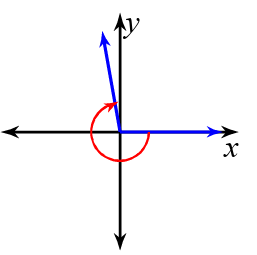
Example 7 :
Find the measure of each principal angle.
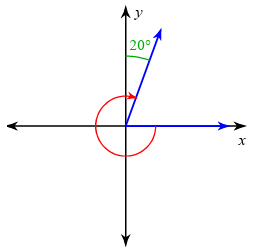
Solution :
The terminal side lies in the first quadrant, the initial arm is rotating in clockwise direction, the angle measure shown is 20 degree.
Principal angle = -270 - 20
= -290 degree
Example 8 :
Find the measure of each principal angle.
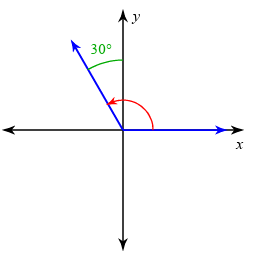
Solution :
The terminal side lies in the second quadrant, the initial arm is rotating in counter clockwise direction, the angle measure shown is 30 degree.
Principal angle = 90 + 30
= 120 degree
Example 9 :
Find the measure of each principal angle.
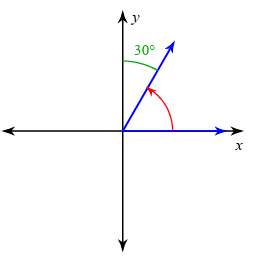
Solution :
The terminal side lies in the first quadrant, the initial arm is rotating in counter clockwise direction, the angle measure shown is 30 degree. The angle measure shown must be a positive angle measure.
Principal angle = 90 - 30
= 60 degree
Example 10 :
Find the measure of each principal angle.
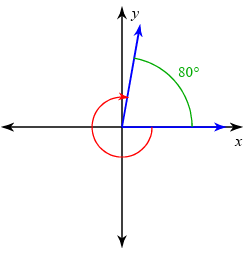
Solution :
The terminal side lies in the first quadrant, the initial arm is rotating in clockwise direction, the angle measure shown is 30 degree. The shown angle measure must be a negative angle.
Principal angle = -360 + 80
= -280 degree
Example 11 :
State the quadrant in which the terminal side of each angle lies.
1) 300° 2) 170° 3) 235° 4) −229°
Solution :
1) 300°
The given angle measure lies between 270 degree to 360 degree, then the terminal arm should lie in the third quadrant.
2) 170°
The given angle measure lies between
90 degree to 180 degree, then the terminal arm should lie in the second quadrant.
3) 235°
The given angle measure lies between 180 degree to 270 degree, then the terminal arm should lie in the third quadrant.
4) −229°
The given angle measure lies between -180 degree to -270 degree, then the terminal arm should lie in the third quadrant.
Subscribe to our ▶️ YouTube channel 🔴 for the latest videos, updates, and tips.
Kindly mail your feedback to v4formath@gmail.com
We always appreciate your feedback.
About Us | Contact Us | Privacy Policy
©All rights reserved. onlinemath4all.com

Recent Articles
-
10 Hard SAT Math Questions (Part - 40)
Dec 25, 25 08:30 AM
10 Hard SAT Math Questions (Part - 40) -
10 Hard SAT Math Questions (Part - 41)
Dec 24, 25 07:58 PM
10 Hard SAT Math Questions (Part - 41) -
ASTC Formula in Trigonometry
Dec 23, 25 11:34 PM
ASTC Formula in Trigonometry - Concepts - Examples and Solved Problems


